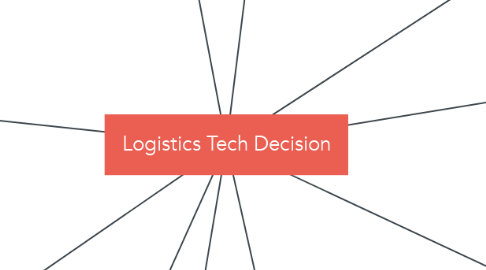
1. Future Proofing
1.1. Software
1.1.1. Scalability
1.1.2. Support Life
1.1.3. Version Control
1.1.4. Replacement Software
1.2. Hardware
1.2.1. Interoperatibility
1.2.2. Redundancy
1.2.3. Lifetime Expectations
1.2.3.1. Bathtub Chart
1.3. Vendor Stability
1.3.1. Startup
1.3.2. Established Player
1.3.3. Partnerships
2. Integrations
2.1. Legacy Systems
2.1.1. Export capabilities
2.1.2. Import capabilities
2.1.3. 3rd-party dependencies
2.1.4. Existing Data Quality
2.1.5. Expected Lifetime
2.1.6. Future functionality
2.2. Planned Systems
2.2.1. Current Scope
2.2.2. Is there a priority?
2.2.3. Additional Requirements
2.3. Suppliers
2.3.1. Existing Capability
2.3.2. Planned Capability
2.3.3. Supplier Ranking
2.3.4. Cost to Suppliers
2.4. Customers
2.4.1. Existing Capability
2.4.2. Planned Capability
2.4.3. Customer Ranking
2.4.4. Cost to Customers
2.4.5. Effect on new Sales
2.4.5.1. Restrictions on growth
2.4.5.2. Opportunities for new Biz
3. Don't Change
3.1. Legacy Systems
3.1.1. Assess Capabilities
3.1.1.1. What is the current tech capable of?
3.1.1.2. Are all options activated?
3.1.2. Explore Upgrades
3.1.3. Software
3.1.4. Hardware
3.1.4.1. Upgrade
3.1.4.2. 2nd hand
3.1.4.2.1. Larger Carriers Upgrading
3.1.4.2.2. Vendor Refurbishments
3.2. Scenario Planning
3.2.1. Still need a plan
3.2.2. Explore Redundant Systems
3.2.3. Budget for failure
3.2.3.1. Disaster Recovery
3.2.3.2. Eventual Replacement
3.3. Operational Change
3.3.1. Tech to fix ops
3.3.2. Tech to plug holes
3.3.3. Tech for tech's sake
4. Support
4.1. Tech Support
4.1.1. Local
4.1.1.1. In Person
4.1.1.2. On Site
4.1.1.3. Trained Staff
4.1.1.4. Embedded
4.1.1.5. Response times
4.1.1.6. Escalation
4.1.2. Offshore
4.1.2.1. Access
4.1.2.2. Dedicated/Shared
4.1.2.3. Service Level Agreement
4.1.2.3.1. Response times
4.1.2.3.2. Escalation
4.1.2.4. Language
4.1.2.5. Cultural Understanding
4.1.3. Ondemand
4.1.3.1. Service Level Agreement
4.1.3.2. Shared Resources
4.1.3.3. Exclusive Resources
4.1.4. 24/7 availability
4.1.4.1. Required?
4.1.4.2. Outside Business Hours
4.1.4.3. Emergency Contacts
4.2. Sales Support
4.2.1. Onboarding Staff
4.2.1.1. Training
4.2.1.2. Retraining
4.2.1.3. Champions
4.2.2. Transition
4.2.2.1. Planning
4.2.2.2. Management
4.2.2.3. Follow up
4.2.2.4. Supplier Support
4.2.2.5. Customer Support
5. Research
5.1. Review Sites
5.1.1. Check for paid content
5.1.2. Check for trusted reviews
5.1.3. Review the Reviewers
5.2. Blogs
5.3. Similar Companies
5.3.1. Competitors
5.3.2. Partners
5.4. Local
5.5. International
5.6. Existing vendors
5.7. Market Leaders
5.8. Search Engines
5.8.1. Don't forget Bing
5.8.2. LinkedIn
5.8.2.1. LinkedIn Groups
5.8.2.2. Thought Leaders
5.9. Consultants
5.9.1. Pay for Service
5.9.2. Commission Agents
5.9.3. Ad hoc work
5.9.4. Long term strategic
6. Which Technology
6.1. Cloud
6.2. Local
6.3. Mobile
6.3.1. IOS
6.3.2. Android
6.3.3. Mobile Web
6.4. Hardware
6.4.1. Bring Your Own Device
6.4.2. Company-Owned
6.4.2.1. Costs
6.4.2.2. Insurance
6.4.2.3. Capability
6.4.2.4. Safety and Security
6.5. Platform Age
6.5.1. Established
6.5.2. New
6.5.3. Startup
6.5.4. Multinational
7. Reliability
7.1. Hardware
7.1.1. Moving Parts
7.1.2. Tech Stack
7.1.3. Spare Parts in Australia
7.1.4. Interchangeability
7.1.5. Warranty
7.1.5.1. Back to Base
7.1.5.2. Onsite
7.1.5.3. Response times
7.1.5.4. Replacement or Loan Units
7.2. Software
7.2.1. Local
7.2.1.1. Operating System
7.2.1.2. Updates, Patches, Bug Fixes
7.2.1.3. Mystery Box?
7.2.1.4. Transferability
7.2.2. Cloud
7.2.2.1. Server Uptime
7.2.2.2. Local or international hosting
7.2.2.3. Updates, Patches, Bug Fixes
7.2.2.4. Major updates - time of day
8. Costs
8.1. Set up costs
8.1.1. External Tech
8.1.2. Internal Tech
8.1.3. Downtime
8.1.4. Data Transfer
8.1.5. New Hardware
8.2. Ongoing Costs
8.2.1. Licence Fees
8.2.1.1. SLA Rebates
8.2.1.2. Uptime Guarantees
8.2.1.3. Hidden Charges
8.2.1.3.1. Other Software Dependencies
8.2.1.3.2. Extra Service after a period
8.2.1.3.3. Excess data or transactions
8.2.2. Subscription Model
8.2.2.1. Pay per week
8.2.2.2. Pay per month
8.2.2.3. Pay per year incentives
8.2.2.4. Seats/Users
8.2.2.4.1. Active vs Licenced
8.2.2.4.2. User Level Requirements
8.2.3. Replacement Hardware
8.3. Costs NOT to change
8.3.1. BAU
8.3.2. Missed Opportunities
8.3.3. Supplier Resistance
8.3.4. Customer Resistance
9. Security
9.1. Cloud
9.1.1. Onshore Data
9.1.1.1. Physical Datacentre Security
9.1.1.2. Virtual Security
9.1.1.3. Track Data Ownership
9.1.1.4. Aus Gov Access
9.1.1.5. Data retention policies
9.1.2. Offshore Data
9.1.2.1. GDPR exposure
9.1.2.2. Other Jurisdictions
9.1.2.3. Data transmission
9.1.3. Conflicts of Interest
9.1.3.1. Other Customers of provider
9.1.3.2. Company ownership
9.1.3.3. Competitors
9.1.4. Fencing
9.1.4.1. Protection of data
9.1.4.2. Virus Security
9.2. Hardware
9.2.1. Device Tracking
9.2.1.1. Remote Termination
9.2.1.2. Back to Base Location
9.2.2. PIN/Login
9.2.3. Data on Device
9.2.4. Connection to network
9.2.5. BYOD
9.2.5.1. Shared resources
9.2.5.2. Shared Apps
9.2.5.3. Employee/Contractor Onboarding
9.2.5.4. Employee/Contractor Departure
9.2.6. Batteries
9.2.6.1. Charging Equipment
9.2.7. Shared devices
9.2.7.1. User Tracking
9.2.7.2. Device Hygiene
9.2.7.2.1. Sanitisation
9.2.7.2.2. Screen Protection
9.2.7.2.3. Keypad Guards
9.3. Software
9.3.1. Local
9.3.2. Hybrid
10. Timing
10.1. Crisis Events
10.1.1. Urgency
10.1.2. Short or long term solutions
10.2. Planned Obsolescence
10.3. 3, 5, 7 year masterplans
10.3.1. Tech strategy in line with group
10.3.2. New depots and operations
10.3.3. Does it scale?
10.4. Tactical Timing
10.4.1. Quiet time during year
10.4.2. Staged rollouts
10.4.3. Weekend and evening switch over

